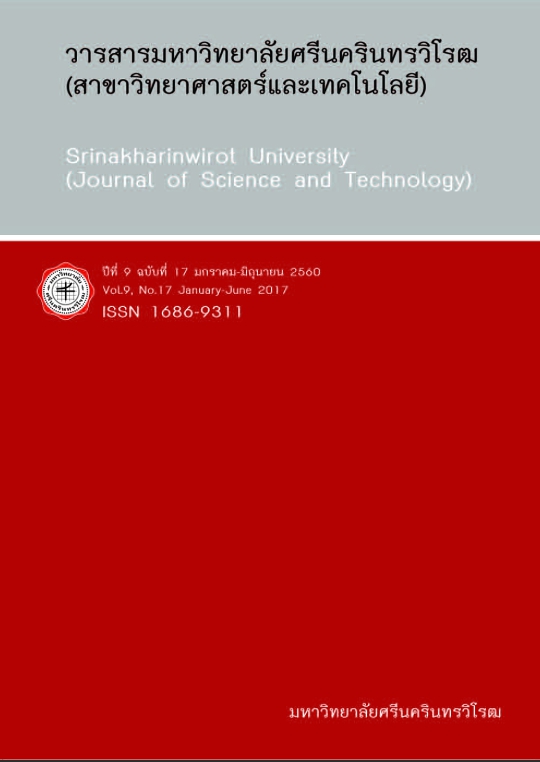การศึกษา และพัฒนาต้นเชื้อผักดองสำหรับผลิตน้ำหมักชีวภาพที่ได้จากพืชเพื่อการบริโภค STUDY AND DEVELOPMENT OF PICKLED STARTER FOR PRODUCING OF BIOLOGICALLY FERMENTED PLANT FOR CONSUMPTION
Keywords:
Pickled Starter, Biologically Fermented, Indigenous Crop, Safety and HealthAbstract
บทคัดย่อ
การศึกษาและการพัฒนาต้นเชื้อผักดองสำหรับผลิตน้ำหมักชีวภาพที่ได้จากพืชเพื่อการบริโภค มีวัตถุประสงค์เพื่อศึกษาปริมาณต้นเชื้อที่สามารถผลิตกรดแลคติคสูงสุดเป็นหัวเชื้อเริ่มต้นในการผลิต น้ำหมักชีวภาพเพื่อการบริโภค โดยนำผักพื้นบ้านจาก 4 ภาคที่นิยมบริโภคมากที่สุด ได้แก่ ผักเสี้ยน (ภาคเหนือ) ผักกาด (ภาคกลาง) หน่อเหรียง (ภาคใต้) และผักกาดกรุง (ภาคอีสาน) นำมาดองเพื่อศึกษาปริมาณของต้นเชื้อ ผักดองที่สามารถผลิตกรดแลคติคสูงสุดในการหมักเพื่อใช้เป็นหัวเชื้อเริ่มต้นในการผลิตน้ำหมักชีวภาพจาก ลูกยอชนิดละ 4 สูตร (ที่ระดับเชื้อเริ่มต้น 0, 5, 10 และ 15%) สูตรละ 3 ถัง รวมเป็น 39 ถัง และทำการเก็บตัวอย่างน้ำหมักที่ได้ในวันที่ 0, 1, 3, 5, 7, 10, 15, 20 และ 30 วัน จากการศึกษาพบว่า ผักเสี้ยน และหน่อเหรียงใช้เวลาในการดอง 5 วัน ผักกาดใช้เวลาในการดอง 7 วัน และผักกาดกรุงใช้เวลาในการดอง 6 วัน มีความเหมาะสมในการเป็นต้นเชื้อเริ่มต้นในการทำน้ำหมักต่อไป และขั้นตอนในการผลิตน้ำหมักชีวภาพ ทั้ง 13 สูตร
โดยทำการเปรียบเทียบกับสูตรที่ 1 เป็นสูตรมาตรฐาน (ไม่ใส่ต้นเชื้อในการหมัก) จากการศึกษาพบว่า สูตรที่ 4 มีน้ำผักเสี้ยนดองเป็นหัวเชื้อเริ่มต้นที่ 15% สูตรที่ 7 มีน้ำผักกาดดองเป็นหัวเชื้อเริ่มต้นที่ 15% สูตรที่ 10 มีน้ำหน่อเหรียงดองเป็นหัวเชื้อเริ่มต้นที่ 15% และสูตรที่ 13 มีน้ำผักกาดกรุงดองเป็นหัวเชื้อเริ่มต้นที่ 15% ให้คุณภาพน้ำหมักที่มีความเหมาะสมต่อผู้บริโภคมากที่สุด จากการวิเคราะห์ทางด้านชีวภาพไม่พบแบคทีเรียก่อโรค (แบคทีเรียโคลิฟอร์ม และแบคทีเรีย E. coli) จึงทำให้มีความปลอดภัยต่อผู้บริโภค ด้านการทดสอบทางประสาทสัมผัส พบว่าสูตรที่ 6 ผู้ทดสอบให้คะแนนความพึงพอใจในลักษณะด้านกลิ่น รสหวาน และความชอบโดยรวมมากที่สุด
จึงเหมาะที่จะเป็นน้ำหมักชีวภาพสำหรับการบริโภคเพื่อส่งเสริมด้านสุขภาพได้
Abstract
Study and development of pickled starter for producing of biologically fermented plant for consumption. The purpose was to study the amount of inoculum that can produce lactic acid maximum. To start a leavening agent in the production of bio-fermentation for consumption. By the vegetables consumed the most in four regions, four types were Tare (North), Lettuce (central), Bud rieng (South) and Lettuce (Northeast) be preserved for study the amount of inoculum. Pickles that can produce lactic acid is best to compost for use as leavening begins to produce fermented Noni kind of 4 recipes (at inoculum 0, 5, 10 and 15%) 3 tanks each for a total of 39 tanks, fermentation broth samples were collected at 0, 1, 3, 5, 7, 10, 15, 20 and 30 days. The study found that Tare and shoots Rieng both take time to pickle 5 days, turnips take on pickled 7 days and lettuce used in pickling 6 days, which it is appropriate to use as a leavening start to use in the next step and bio-fermentation process to produce the 13 recipes by comparison with the first series is a standard formula. (No leavening in fermentation). The study found that the formula 4 with a tare preserved spider weed fermented as leavening begins at 15%, the formula 7 with a pickle mustard fermented as leavening begins at 15%, formula 10 with Bud rieng fermented as leavening begins at 15% and formula 13 with a Lettuce fermented as leavening begins at 15%, the quality fermentation that is suitable for most consumers. The analysis of biological pathogenic bacteria was not found. (Coliform bacteria and E. coli), making it safe for consumers. Sensory testing showed that the formula 6, the test scores in aroma, flavor and overall liking the most. It is ideal to be fermented to consume for health.
Downloads
Downloads
Published
How to Cite
Issue
Section
License
Srinakharinwirot University Journal of Sciences and Technology is licensed Under a Creative Commons Attribution-NonCommercial-NoDerivs 4.0 International (CC-BY-NC-ND 4.0) License, Unless Otherwise Stated. Please Read Journal Policies Page for More Information on Open Access, Copyright and Permissions.



